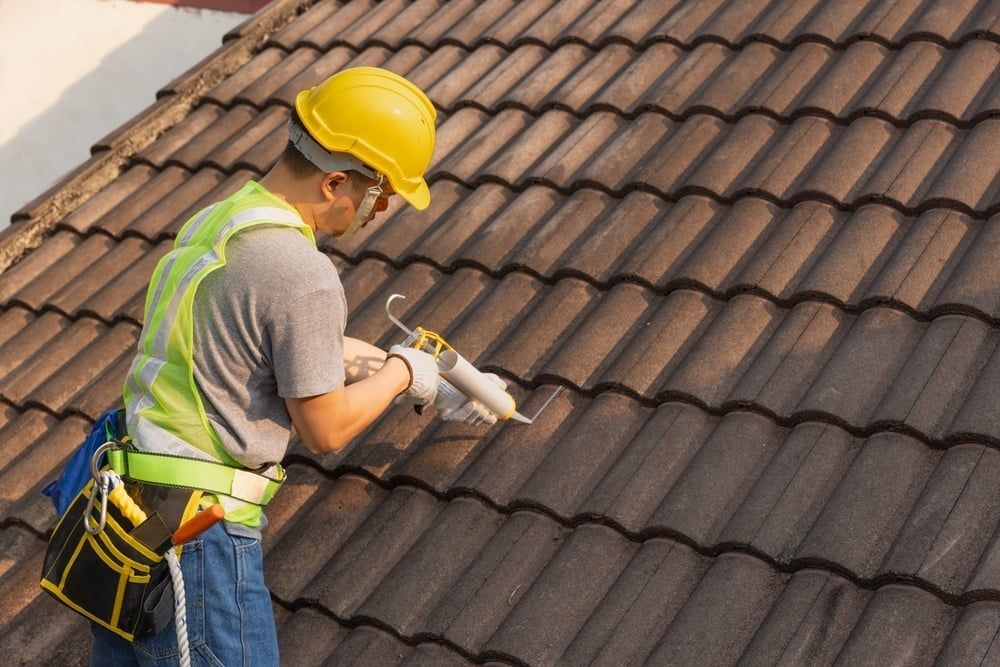In Cranbourne, heavy rainstorms are common , and a sudden roof leak can cause serious problems if not dealt with quickly. Even a small leak may lead to structural damage, mold growth and costly repairs over time. For effective roof leak repair, start by containing the water, then locate the leak safely and apply a temporary cover such as a tarp or roofing tape. After the storm, perform a thorough inspection and arrange a permanent repair or call a licensed roofer if needed. Acting fast reduces damage and repair costs.
Essential Steps to Manage a Roof Leak Immediately
- Put buckets or containers under drips and protect valuables.
- Move furniture, rugs and electronics away from the wet area.
- If safe, cover the affected roof area with a tarp or heavy plastic.
Inspect the attic/ceiling for stains to help locate the source. - Use roofing tape or sealant as a temporary patch; arrange professional roof leak repair afterwards.
Step 1: Contain the Leak and Minimize Damage
Buckets placed to catch leaking water from a damaged roof. Think of this like damage control. The moment you spot that dreaded wet spot or hear a drip, it’s Go Time. First, protect your stuff: put buckets or containers under any drips to catch water. Move furniture, electronics or favourite carpets out of the splash zone don’t let one leaky roof ruin your favourite armchair. Lay down old towels or plastic sheeting to soak up spills. This simple act can save hours of clean-up and hundreds in damage.
Next, find a quick cover for the leak. If it’s still raining, and you can safely get outside ,throw a tarp or heavy plastic sheet over the trouble spot. Use staples, nails, bricks or even heavy wood blocks to anchor it down against the wind The goal? Keep as much water out as possible until the storm passes. Roofing pros recommend extending the tarp over the roof ridge and securing it well. Even a hasty tarp job will buy you time until you can make a proper fix.
Step 2: Find the Roof Leak
A homeowner inspects roof beams in the attic to locate a hidden leak. Now that the immediate mess is under control, it’s time to play detective. For any roof leak repair, locating the leak is key – you can’t repair what you haven’t found. Often, the visible drip isn’t directly under where water entered; it can run along rafters and beams before dripping.
Start indoors. Head to the attic or crawl space during daylight; use a flashlight to look for wet spots, mould, or water stains on the ceiling. If sunlight streams through gaps in the roof sheathing, you might have found the hole! From below, mark any suspicious areas where damp patches appear.
Next, inspect outside if safe. Grab a sturdy ladder and carefully check the roof surface around the leak zone. Look for missing or cracked shingles or tiles, loose or corroded flashing around chimneys and vents, or holes in metal sheets.
If you still can’t spot the leak, enlist a friend. Have them slowly spray water on sections of the roof while you watch inside for new drips. When you see a fresh leak, mark the spot. This “water test” is a pro trick for pinpointing sneaky leaks.
Leak-Spotting Checklist:
- Attic/Ceiling: Check joists and roof boards for drips or rot. Fresh stains on insulation or wood are bad news.
- Roof Surface: Scan for missing, cracked or curled tiles/shingles. Don’t forget metal roofs look for rust, loose fasteners or punctures.
- Flashing & Joints: Examine areas around chimneys, skylights, and plumbing vents. These are common weak spots. Sealant may have cracked or metal flashing may have lifted.
- Hose Test: Have a helper spray the roof with a garden hose, section by section. If you see water inside, you’ve found the culprit.
- Professional Tools: Roof plumbers sometimes use thermal cameras or moisture meters to find hidden leaks
Common Causes of Roof Leaks and Quick Fixes
Experts say the usual culprits are damaged shingles, clogged gutters, and worn-out flashing. Here’s a quick cheat-sheet of common problems and how you might patch them temporarily vs permanently:
| Leak Cause | Temporary Fix | Permanent Repair |
| Cracked/Missing Shingles | Cover with roofing tape or sealant; nail on plastic sheeting or tarp | Replace the broken shingles/tiles; seal edges with roofing cement |
| Loose/Damaged Flashing | Apply waterproof sealant or roofing tape over the gap | Remove old flashing, install new flashing and reseal seams |
| Clogged Gutters | Clear the debris so water can flow | Install gutter guards; ensure proper slope and connected downpipes |
| Holes/Rust in Metal Roof | Apply metal roof sealant generously on punctures | Sand away rust; patch with metal roofing compound or replace panel |
| General Aging or Damage | Cover weak spots with tarp; use roof tape from inside attic | Consult a roofer – you may need extensive repairs or even re-roofing |
Step 3: Quick DIY Roof Leak Repairs
With the leak identified, let’s fix it fast. Think of these as emergency roof leak repair fixes. Remember, these are often temporary patches to keep water out:
- Roofing Tape & Sealant: Modern roofing tape and roof sealant are lifesavers. Clean and dry the area around the leak as much as possible, then firmly press roofing tape or a dab of sealant over the gap This can instantly stop interior drips and buy time.
- Replace Missing Shingles: If only a few shingles or tiles are missing or broken, replace them. Pry off old nails, slide in the new shingle, and nail it down. Then smear roofing cement under the edges to hold it tight. This quick replace-and-seal keeps the water out until you can check underlayment or do a full fix.
- Tarp & Roofing Tar: If you have multiple leaks or a large hole, you might need a bigger patch. Throw a tarp over the roof section. For small gaps or cracks, roofing tar or asphalt patch can seal them. As one pro guide notes, anchoring the tarp with heavy blocks and extending it over the ridge helps even in heavy wind.
- Inside Patches: In a true emergency, you can even patch from the ceiling side. In the attic or ceiling, apply roofing tape to the underside of the roofboard. It’s a very temporary fix, but it will slow the leak until you repair from the outside.

Step 4: Permanent Roof Leak Repair
Consider DIY patches like band-aids. Now it’s time to remove the bandaid and fix the underlying problem properly. The exact method depends on your roof material:
- Asphalt Shingles: Remove the damaged shingles and old nails. Slide in new shingles, nail them, then seal the edges with roofing cement. Make sure each course overlaps tightly to shed water.
- Tiles or Metal Roofs: For metal, clean any rust first. Then apply high-quality metal roof sealant generously. If you have a hole, cut a matching patch, secure it, and seal all edges. For ceramic or concrete tiles, replace broken tiles and re-bed them in mortar or sealant.
- Flashing Repair: Often leaks come from faulty flashing . Pry off the old flashing around chimneys or vents, slide in new flashing, and seal well with roofing cement or silicone. Proper flashing work usually stops leaks for good.
- Membrane/Flat Roofs: If you have a flat or low-slope roof with rubber or TPO membrane, cut out the damaged section and apply a matching patch. Clean it thoroughly and use the correct adhesive or hot-air welding to bond the patch.
Sometimes heavy rain reveals multiple problem spots. If several areas need fixing or the roof is very old, consider a full service or replacement. It’s expensive, but better than having constant leaks.
When to Call a Professional for Roof Leak Repair
Let’s be honest: not every roof leak repair is a DIY job. If your quick fix hasn’t held, or you’ve got a massive leak , ring a local Cranbourne roof plumber. These pros have the right tools and know-how to diagnose and fix the problem correctly.
Choosing a roofer: Look for licensed roofers or “roof plumbers” who cover Cranbourne. Check reviews or ask friends. Make sure they’re insured and offer a warranty. Getting 2–3 quotes is wise. Industry guides note that a credible pro will save you money in the long run by doing it right the first time.
Prevent Future Leaks
Once the leak is history, don’t wait for the next storm. Schedule regular roof check-ups. Keep your gutters clean of leaves and debris, backups and overflows can send water under your tiles. Trim back tree branches near the roof; they scrape and can seed debris.
Some quick tips to lock it down:
- Clean Gutters/Downpipes: Free-flowing gutters direct water away from your roof and foundations.
- Inspect Flashing and Seals: Check around chimneys, skylights, and vents. If you see gaps or cracks, re-caulk them promptly.
- Roof Coatings: In our climate, some homeowners use reflective or waterproof roof coatings on metal roofs. These seal minor cracks and reduce future leaks.
- Trim Trees: Keep trees a safe distance. Fewer leaves up top means fewer clogs and less moss.
Think of your roof as your home’s umbrella – it needs care to keep you dry. A bit of preventive maintenance now can save a full roof overhaul later.
Conclusion
According to Tenants Victoria – Repairs and Maintenance, a leaking roof is no fun, but with the right moves, you can handle it quickly and calmly. Start by containing the damage, then locate and temporarily patch the leak. Once the storm passes, do the proper repairs or call in a pro. Acting fast is key; it protects your home and your wallet.
As one guide reminds us, “repairing or patching tiny roof leaks is something you can accomplish yourself with a little knowledge and the right tools.” So if you ever hear that drip, drip, drip, you’ll know exactly what to do. And remember: prompt roof leak repair is your best defense against future disasters
Now, how about you? Have any wild roof-leak war stories or genius DIY fixes of your own? Drop a comment or share this post so your neighbours know how to stop that drip, drip, drip too! And if you’ve tackled a leaky roof, share your roof leak repair tips or horror stories below let’s help each other keep Cranbourne homes dry.

